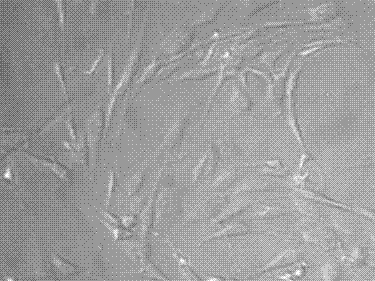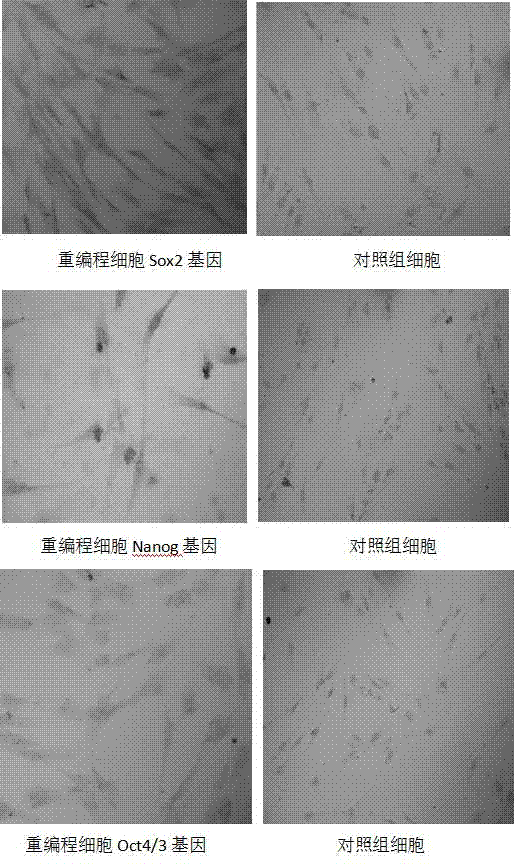Preparation method and application of cell-stent composite material for cartilage injury repairing
A composite material and cartilage damage technology, applied in the field of bone tissue engineering and regenerative medicine, can solve the problem of not finding materials and methods for repairing cartilage damage
- Summary
- Abstract
- Description
- Claims
- Application Information
AI Technical Summary
Problems solved by technology
Method used
Image
Examples
Embodiment 1
[0039] Fish oocyte extract induces reprogramming of rabbit skin fibroblasts into induced pluripotent stem cells.
[0040] In this example, the fibroblasts were derived from the skin tissue on the back of rabbits, and the technical route for the research of fish oocyte extracts to induce the reprogramming of rabbit skin fibroblasts into induced pluripotent stem cells is shown in the attached figure 1 shown, including the following steps.
[0041] (1) Preparation of fish oocyte extract Select the local crucian carp produced in Kunming when the oocyte yolk is full, soak it in 75% alcohol for 15-20 minutes, take out the fish eggs under sterile conditions, and put them in pre-cooling Put the mortar on ice for grinding. After fully grinding, add pre-cooled saline at a volume ratio of about 1:1, centrifuge at 1000rpm at 4°C for 10min, and then centrifuge at 3000rpm at 4°C. 10min, take the supernatant, use a 0.22 micron pore filter to filter, use the Coomassie brilliant blue method t...
Embodiment 2
[0048] Preparation of KGM / HA bioscaffolds.
[0049]The preparation materials of the KGM / HA bioscaffold in this example include konjac glucomannan and sodium hyaluronate. The preparation method is as follows: disperse 0.06g HA powder in 40 ml water, stir magnetically, and add 0.08ml NH 3 ·H 2 O adjust the pH value, add 1.50g of KGM according to the design of the orthogonal test table, and continue magnetic stirring at the same time until the stirring stops automatically and seals; it is matured in a water bath at 70°C, and dealkalized under the same conditions; then it is placed in a low-temperature freezer. , frozen at -20°C for 24 hours, then taken out, and finally dried in a freeze dryer to obtain the composite porous scaffold KGM / HA.
[0050] Using optical microscopic analysis and quantitative metallographic analysis, it was found that the prepared KGM / HA scaffold was suitable for the growth of stem cells. The pore size of 100 μm to 250 μm accounted for 80% to 90% of the t...
Embodiment 3
[0052] Preparation of reprogrammed cells and KGM / HA scaffold composites.
[0053] Co-cultivate the reprogrammed cells prepared in Example 1 and the KGM / HA scaffold prepared in Example 2 to prepare the reprogrammed cell-KGM / HA scaffold composite material, the method and steps are as follows: (1) Implement the The aseptically treated KGM / HA scaffold prepared in Example 2 was placed in a six-well plate for cell culture; (2) Suspended in the DMEM / F12 medium containing 10% fetal bovine serum prepared in Example 1 of reprogrammed cells and adjust their concentration to 1 x 10 per ml 6 (3) inoculate the reprogrammed cells with adjusted concentration on the sterile KGM / HA composite material in the six-well plate in the step (1), inoculate 5ml in each well; (4) inoculate the Place the six-well culture plate seeded with reprogrammed cells in step (3) at 37°C, 5% CO 2 1. Cultivate under 90% humidity conditions, replace the culture medium every two days, and cultivate for 10 days; (5) A...
PUM
| Property | Measurement | Unit |
|---|---|---|
| weight | aaaaa | aaaaa |
Abstract
Description
Claims
Application Information
 Login to View More
Login to View More - R&D
- Intellectual Property
- Life Sciences
- Materials
- Tech Scout
- Unparalleled Data Quality
- Higher Quality Content
- 60% Fewer Hallucinations
Browse by: Latest US Patents, China's latest patents, Technical Efficacy Thesaurus, Application Domain, Technology Topic, Popular Technical Reports.
© 2025 PatSnap. All rights reserved.Legal|Privacy policy|Modern Slavery Act Transparency Statement|Sitemap|About US| Contact US: help@patsnap.com



